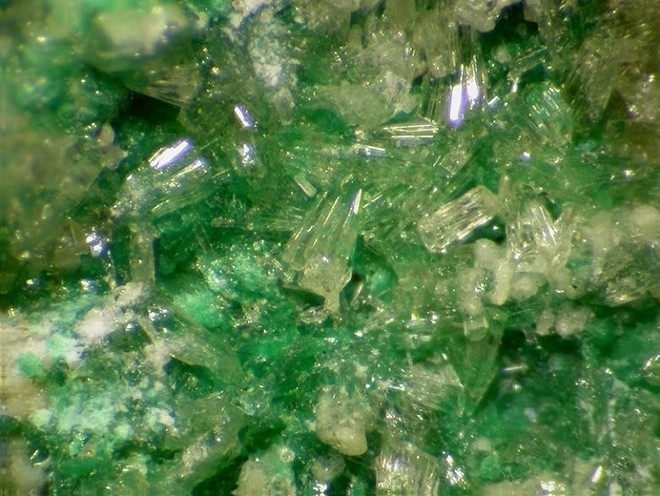Sanrománite
A valid IMA mineral species
This page is currently not sponsored. Click here to sponsor this page.
About Sanrománite
Formula:
Na2CaPb3[CO3]5
Colour:
Colourless, green-yellow
Lustre:
Vitreous
Specific Gravity:
5.20 (Calculated)
Crystal System:
Hexagonal
Member of:
Name:
Named for the Chilean naturalist (mineralogy and geology) Francisco J. San Román (ca 1838 Copiapó - 1902 Santiago de Chile)
Unique Identifiers
Mindat ID:
29029
Long-form identifier:
mindat:1:1:29029:2
GUID
(UUID V4):
(UUID V4):
5680e51d-8e79-4ef8-aa5e-ef1b3f165ba7
Classification of Sanrománite
Approved
Approval year:
2006
First published:
2007
5.AC.30
5 : CARBONATES (NITRATES)
A : Carbonates without additional anions, without H2O
C : Alkali and alkali-earth carbonates
5 : CARBONATES (NITRATES)
A : Carbonates without additional anions, without H2O
C : Alkali and alkali-earth carbonates
14.4.4.4
14 : ANHYDROUS NORMAL CARBONATES
4 : Miscellaneous
14 : ANHYDROUS NORMAL CARBONATES
4 : Miscellaneous
Mineral Symbols
As of 2021 there are now IMA–CNMNC approved mineral symbols (abbreviations) for each mineral species, useful for tables and diagrams.
| Symbol | Source | Reference |
|---|---|---|
| Srm | IMA–CNMNC | Warr, L.N. (2021). IMA–CNMNC approved mineral symbols. Mineralogical Magazine, 85(3), 291-320. doi:10.1180/mgm.2021.43 |
Physical Properties of Sanrománite
Vitreous
Transparency:
Transparent
Colour:
Colourless, green-yellow
Streak:
White
Tenacity:
Brittle
Cleavage:
None Observed
Density:
5.20 g/cm3 (Calculated)
Chemical Properties of Sanrománite
Formula:
Na2CaPb3[CO3]5
IMA Formula:
Na2CaPb3(CO3)5
Crystallography of Sanrománite
Crystal System:
Hexagonal
Class (H-M):
6mm - Dihexagonal Pyramidal
Space Group:
P63mc
Cell Parameters:
a = 10.553(1) Å, c = 6.641(1) Å
Ratio:
a:c = 1 : 0.629
Unit Cell V:
640.5 ų
Z:
2
Morphology:
Crystals are elongated along [0001] and show the forms {1010} and {1121}.
Twinning:
Occurs on (1120).
X-Ray Powder Diffraction
Powder Diffraction Data:
| d-spacing | Intensity |
|---|---|
| 3.769 Å | (100) |
| 3.323 Å | (43) |
| 3.066 Å | (51) |
| 2.688 Å | (50) |
| 2.640 Å | (65) |
| 2.161 Å | (50) |
| 2.066 Å | (34) |
| 1.993 Å | (44) |
Geological Environment
Paragenetic Mode(s):
| Paragenetic Mode | Earliest Age (Ga) |
|---|---|
| Stage 7: Great Oxidation Event | <2.4 |
| 47c : [Carbonates, phosphates, borates, nitrates] |
Type Occurrence of Sanrománite
General Appearance of Type Material:
Radiating acicular or artichoke-like aggregates, and as isolated needles.
Place of Conservation of Type Material:
Mineralogisches Museum, Universität Hamburg, Hamburg, Germany, numbers MD 211, MD 209, C 904.
Geological Setting of Type Material:
Oxidation zone of a polymetallic vein deposit.
Associated Minerals at Type Locality:
Synonyms of Sanrománite
Other Language Names for Sanrománite
German:Sanromanit
Relationship of Sanrománite to other Species
Member of:
Other Members of this group:
| Burbankite | (Na,Ca)3(Sr,Ba,Ce)3(CO3)5 | Hex. 6mm : P63mc |
| Calcioburbankite | Na3(Ca,REE,Sr)3(CO3)5 | Hex. 6mm : P63mc |
| Khanneshite | (Na,Ca)3(Ba,Sr,Ce,Ca)3(CO3)5 | Hex. 6mm : P63mc |
| Petersenite-(Ce) | Na4(Ce,La,Nd)2(CO3)5 | Mon. 2 : P21 |
| Rémondite-(Ce) | Na3(Ce,Ca,Na)3(CO3)5 | Mon. 2 : P21 |
| Rémondite-(La) | Na3(La,Ca,Na)3(CO3)5 | Mon. 2 : P21 |
Common Associates
Associated Minerals Based on Photo Data:
| 11 photos of Sanrománite associated with Juangodoyite | Na2Cu(CO3)2 |
| 8 photos of Sanrománite associated with Malachite | Cu2(CO3)(OH)2 |
| 3 photos of Sanrománite associated with Chalconatronite | Na2Cu(CO3)2 · 3H2O |
| 3 photos of Sanrománite associated with Calcite | CaCO3 |
| 1 photo of Sanrománite associated with Trona | Na3H(CO3)2 · 2H2O |
| 1 photo of Sanrománite associated with Nahcolite | NaHCO3 |
| 1 photo of Sanrománite associated with Abellaite | NaPb2(CO3)2(OH) |
Related Minerals - Strunz-mindat Grouping
| 5.AC.05 | Eitelite | Na2Mg(CO3)2 |
| 5.AC.10 | Nyerereite | Na2Ca(CO3)2 |
| 5.AC.10 | Zemkorite | Na2Ca(CO3)2 |
| 5.AC.15 | Bütschliite | K2Ca(CO3)2 |
| 5.AC.20 | Fairchildite | K2Ca(CO3)2 |
| 5.AC.25 | Shortite | Na2Ca2(CO3)3 |
| 5.AC.30 | Burbankite | (Na,Ca)3(Sr,Ba,Ce)3(CO3)5 |
| 5.AC.30 | Calcioburbankite | Na3(Ca,REE,Sr)3(CO3)5 |
| 5.AC.30 | Khanneshite | (Na,Ca)3(Ba,Sr,Ce,Ca)3(CO3)5 |
Fluorescence of Sanrománite
Not fluorecent.
Other Information
Notes:
Easily soluble in concentrated HCl with strong effervescence. It decomposes slowly in concentrated nitric and sulphuric acids leading to respectively a white and a bluish-white residue.
Health Risks:
No information on health risks for this material has been entered into the database. You should always treat mineral specimens with care.
Internet Links for Sanrománite
mindat.org URL:
https://www.mindat.org/min-29029.html
Please feel free to link to this page.
Please feel free to link to this page.
Search Engines:
External Links:
References for Sanrománite
Reference List:
Localities for Sanrománite
Locality List
 - This locality has map coordinates listed.
- This locality has map coordinates listed.
 - This locality has estimated coordinates.
ⓘ - Click for references and further information on this occurrence.
? - Indicates mineral may be doubtful at this locality.
- This locality has estimated coordinates.
ⓘ - Click for references and further information on this occurrence.
? - Indicates mineral may be doubtful at this locality.
 - Good crystals or important locality for species.
- Good crystals or important locality for species.
 - World class for species or very significant.
(TL) - Type Locality for a valid mineral species.
(FRL) - First Recorded Locality for everything else (eg varieties).
- World class for species or very significant.
(TL) - Type Locality for a valid mineral species.
(FRL) - First Recorded Locality for everything else (eg varieties).
All localities listed without proper references should be considered as questionable.
Chile | |
| |
| |
Spain | |
|
Quick NavTopAbout SanromániteUnique IdentifiersClassification Mineral SymbolsPhysical Properties Chemical Properties Crystallography X-Ray Powder DiffractionGeological EnvironmentType Occurrence SynonymsOther LanguagesRelationshipsCommon AssociatesStrunz-MindatFluorescence Other InformationInternet Links References Localities Locality List





 symbol to view information about a locality.
The
symbol to view information about a locality.
The 



Santa Rosa Mine, Santa Rosa-Huantajaya mining district, Iquique Province, Tarapacá, Chile